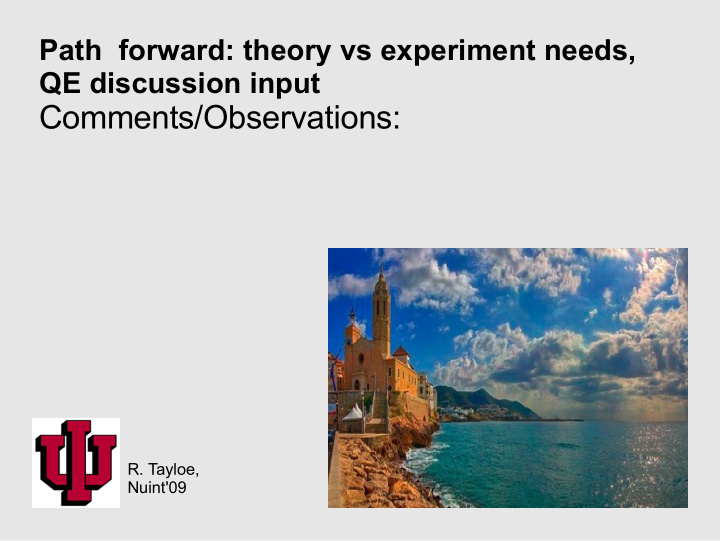



Path forward: theory vs experiment needs, QE discussion input Comments/Observations: R. Tayloe, Nuint'09
Path forward: theory vs experiment needs, QE discussion input Comments/Observations: - Desperately seeking: model-independent cross section measurements - M A , what the ...? - κ , RFG-blasphemy? R. Tayloe, Nuint'09
Desperately seeking: model-independent cross sections - IMHO, best approach to providing xsections needed for oscillations is to develop a solid understanding of theory - Requires, from experiments, unbiased, model-independent observables: cross sections! - need fluxes (with errors) to do this, no xsection based tuning
Jon Link, Nov. 18, 2005 Fermilab Wine & Cheese seminar Brookhaven r e b AGS m a h C e l b b u B D 2 t f 7 They didn’t even try to determine their ν flux from pion production and beam dynamics. In subsequent cross section analyses the theoretical (“known”) quas-ielastic cross section and observed quasi-elastic events were used to determine the flux. 05/19/2009 Teppei Katori, MIT 4
Desperately seeking: model-independent cross sections - IMHO, best approach to providing xsections needed for oscillations is to develop a solid understanding of theory - Requires, from experiments, unbiased, model-independent observables: cross sections! - need fluxes (with errors) to do this, no xsection based tuning - careful with model-dependent kinematics (eg: E ν , Q 2 ), model-ind variables best (eg: T µ , θ µ or si milar ) - Careful with background subtraction. This can add more model- dependence (and uncertainy) than is needed. Perhaps one should not subtract? (eg: bckgd to CCQE: CCpi+pi abs subtracted? or not?) Some (many?) theorists prefer no subtraction. - M A is not a model-ind. observable - Requires, from theory, models for ν interactions... - if to be as serious event generator, also need: - complete kinematics (eg: down to low-Q 2 ) - adjustable parameters (knobs to tune), or exps will add their own...
- M A , what the ...? Higher value for M A (CCQE) in some recent experiments (compared to older results) - Data excess in ~0.3-0.8 GeV 2 range when compared to RFG model with M A =1.0 GeV - K2K, MiniBooNE, MINOS from shape-only fits - MiniBooNE, MINOS rate (xsection) is high as well. Coincidence? - nuclear effects? not yet clear...? - Q 2 shape does change with nuc. effects, but enough? - total xsection is always suppressed with nuc. effects alone. - is old M A smaller because of light targets? - since nuc effects small, then no? MiniBooNE CCQE data - NOMAD result T, Katori Nuint09 - C target, lower M A value, but higher energy? - SciBooNE will weigh in very soon, Mineva also. - Experiments should produce model ind results (xsections, not just MA) so data may be fully explored by modelers
κ , RFG-blasphemy? κ has proved useful in tuning RFG to explain low-Q 2 data - for MiniBooNE Similar effects seen in other experiments - latest MiniBooNE CCQE data consistent with κ =1.0 - still a useful parameter for better fit at low Q 2 - and is supported by e-scattering data (next slides, from Teppei Katori)
4. Pauli blocking parameter “kappa”, κ We performed shape-only fit for Q 2 distribution to fix CCQE shape within RFG eff (effective axial mass) and κ model, by tuning M A Pauli blocking parameter "kappa”, κ Smith and Moniz, Nucl.,Phys.,B43(1972)605 To enhance the Pauli blocking at low Q 2 , we introduced a new parameter κ , which is the energy scale factor of lower bound of nucleon sea in RFG model in Smith- Moniz formalism, and controls the size of nucleon phase space ( ) = κ + − + Elo (p 2 M 2 ) w E F B final nucleon phase space Initial nucleon k+q k+q phase space k k P F Pauli blocked Pauli blocking phase space is enhanced 05/19/2009 Teppei Katori, MIT 8
4. Kappa and (e,e’) experiments In low |q|, The RFG model systematically over predicts cross section for electron scattering experiments at low |q| (~low Q 2 ) Data and predicted xs difference for 12 C triangle: RFG model circle: DWIA model Butkevich and Mikheyev Phys.Rev.C72:025501,2005 05/19/2009 Teppei Katori, MIT 9
4. Kappa and (e,e’) experiments In low |q|, The RFG model systematically over predicts cross section for electron scattering experiments at low |q| (~low Q 2 ) We had investigated the effect of Pauli blocking parameter “ κ ” in (e,e’) data. κ cannot fix the shape mismatching of (e,e’) data for each angle and energy, but it can fix integral of each cross section data, which is the observables for neutrino experiments. We conclude κ is consistent with (e,e’) data. E=730MeV E=240MeV black: (e,e’) θ =37.1 degree θ =60 degree energy transfer Q 2 =0.182GeV 2 Q 2 =0.102GeV 2 data red: RFG model with kappa (=1.019) blue: RFG model without kappa ω (MeV) ω (MeV) 05/17/2009 05/19/2009 Teppei Katori, MIT Teppei Katori, MIT, NuInt '09 10 10
4. Kappa and (e,e’) experiments In low |q|, The RFG model systematically over predicts cross section for electron scattering experiments at low |q| (~low Q 2 ) We had investigated the effect of Pauli blocking parameter “ κ ” in (e,e’) data. κ cannot fix the shape mismatching of (e,e’) data for each angle and energy, but it can fix integral of each cross section data, which is the observables for neutrino experiments. We conclude κ is consistent with (e,e’) data. RFG prediction-(e,e’) data ratio in Q 2 (GeV 2 ) prediction / data red: RFG prediction with kappa (=0.019) blue: RFG prediction without kappa Q 2 (GeV 2 ) 05/17/2009 05/19/2009 Teppei Katori, MIT Teppei Katori, MIT, NuInt '09 11 11
Recommend
More recommend